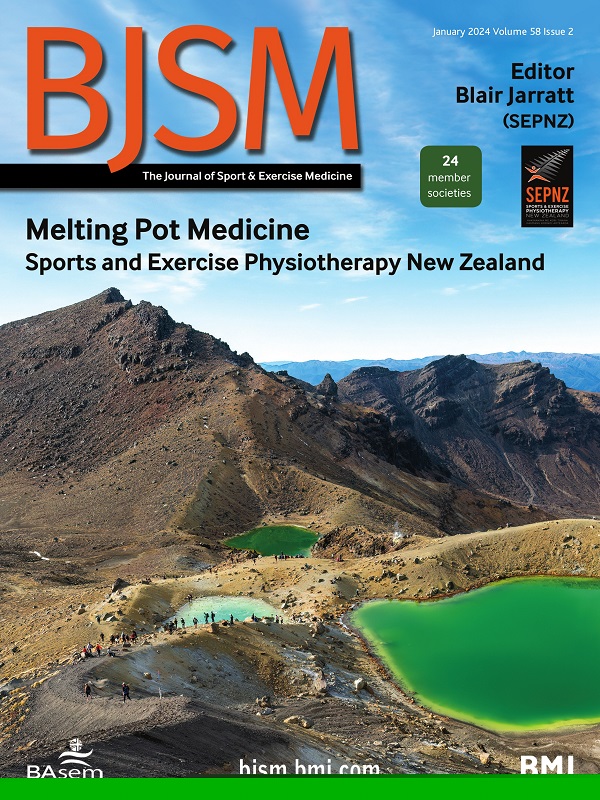孕期急性高强度阻力运动对母体和胎儿的影响
IF 11.6
1区 医学
Q1 SPORT SCIENCES
引用次数: 0
摘要
目的探讨妊娠期孕妇和胎儿对高强度阻力运动的心血管反应。方法选取健康孕妇10例(妊娠期26.4±3.2周)和健康非孕妇10例(年龄分别为34.8±6岁和33.5±2.9岁)。在基线强度测试后至少48小时,以确定10次最大重复(10 RM),参与者完成10次杠铃后蹲,卧推和硬举,以70%,80%和90%的10 RM的自由呼吸,然后以90% 10 RM的Valsalva动作重复10次。持续监测产妇心率。在运动前后立即测定胎儿心率、脐带收缩压/舒张压(S/D)比、阻力指数(RI)、搏动指数(PI)以及母体血压、血糖、乳酸。结果在每次锻炼过程中,孕妇和非孕妇的举重量和感觉劳累率相似。母亲的心率随着举重量的增加而增加,使用Valsalva动作时达到峰值(深蹲:137.3±8.4 bpm;卧推:每分钟110.5±10.4次;硬举:130.7±9.0 bpm)。未观察到胎儿心动过缓,运动前后胎儿心率无变化(深蹲:p=0.639;卧推:p=0.682;硬举:p = 0.847)。脐血流量指标,如RI,在每组深蹲(p=0.642)、卧推(p=0.287)和硬举(p=0.614)中都保持在正常范围内。结论:我们的研究结果表明,母亲和胎儿都能很好地耐受高强度阻力运动,包括使用Valsalva动作时。如有合理要求,可提供资料。本文章由计算机程序翻译,如有差异,请以英文原文为准。
Maternal and fetal responses to acute high-intensity resistance exercise during pregnancy
Objective To examine maternal and fetal cardiovascular responses to high-intensity resistance exercise in pregnancy. Methods 10 healthy pregnant (26.4±3.2 weeks gestation) and 10 healthy non-pregnant individuals were recruited (34.8±6 and 33.5±2.9 years, respectively). At least 48 hours after baseline strength testing to determine 10-repetition maximum (10 RM), participants completed 10 repetitions of barbell back squat, bench press and deadlift at 70%, 80% and 90% of 10 RM with free breathing, followed by 10 repetitions at 90% 10 RM with a Valsalva manoeuvre. Maternal heart rate was monitored continuously. Fetal heart rate, umbilical systolic/diastolic (S/D) ratio, resistive index (RI) and pulsatility index (PI), as well as maternal blood pressure, glucose and lactate were assessed immediately before and after exercise. Results The amount of weight lifted and the rate of perceived exertion by pregnant and non-pregnant participants were similar throughout each exercise. Maternal heart rate increased with the amount of weight lifted, peaking with the use of the Valsalva manoeuvre (squat: 137.3±8.4 bpm; bench press: 110.5±10.4 bpm; deadlift: 130.7±9.0 bpm). Fetal bradycardia was not observed, and fetal heart rate did not change from pre-to-post exercise (squat: p=0.639; bench press: p=0.682; deadlift: p=0.847). Umbilical blood flow metrics, such as RI, remained within normal ranges throughout each set of squats (p=0.642), bench press (p=0.287) and deadlifts (p=0.614). Conclusion Our findings suggest that high-intensity resistance exercises are well tolerated by both mother and fetus, including while using the Valsalva manoeuvre. Data are available upon reasonable request.
求助全文
通过发布文献求助,成功后即可免费获取论文全文。
去求助
来源期刊
CiteScore
27.10
自引率
4.90%
发文量
217
审稿时长
3-8 weeks
期刊介绍:
The British Journal of Sports Medicine (BJSM) is a dynamic platform that presents groundbreaking research, thought-provoking reviews, and meaningful discussions on sport and exercise medicine. Our focus encompasses various clinically-relevant aspects such as physiotherapy, physical therapy, and rehabilitation. With an aim to foster innovation, education, and knowledge translation, we strive to bridge the gap between research and practical implementation in the field. Our multi-media approach, including web, print, video, and audio resources, along with our active presence on social media, connects a global community of healthcare professionals dedicated to treating active individuals.

 求助内容:
求助内容: 应助结果提醒方式:
应助结果提醒方式:


